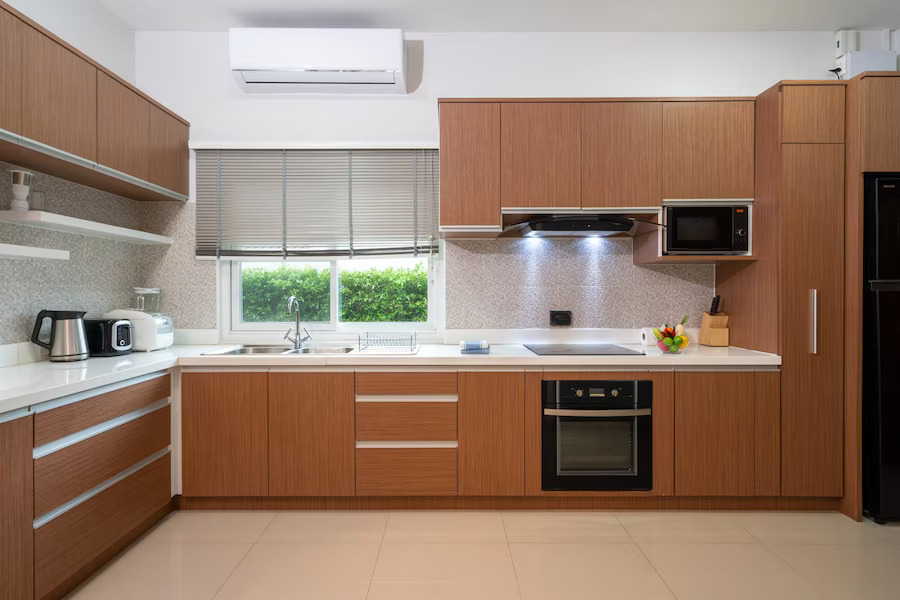
The L-shaped kitchen contains two unfluctuating rows of cabinets and seat space, referred to as the legs of the L. The L-shaped kitchen can retread the length of its legs to unbend the misogynist space due to its flexibility. As a result, this layout suits both small and spacious kitchens. Furthermore, the L-shaped kitchen powerfully utilizes the two proximal walls, forming a functional and socially preferred design, expressly in open-plan living spaces. This layout seamlessly integrates into open-living floor plans, optimises storage, and provides a functional layout. Let’s glance at the advantages and disadvantages to get a largest idea:
Advantages of L-Shaped Kitchen Layout:
Suitable for Compact Areas – Space-Saving Efficiency
The L-shaped kitchen layout is very efficient for small and medium-sized kitchens, as it only needs two walls side-by-side. Consider transforming your galley kitchen into a functional L-shaped kitchen design. Galley kitchens have narrow layouts with counters on opposite sides, which often finger cramped and limited in space. By shifting to an L-shaped layout, you can self-ruling up one wall, creating a sense of openness and permitting easier movement within the kitchen.
Smart Corner Solutions
You can integrate intelligent and stylish corner storage solutions in an L-shaped kitchen layout, such as Le Man’s pullout, Magic Corner, and carousel. These corner solutions maximise the utility of corner spaces by providing efficient storage. The cabinet’s contents inside Le Mans and Magic Corner units are hands visible and wieldy as they swivel outward and toward you upon opening. Conversely, the corner carousel option rotates the cabinet’s contents 360 degrees, providing handy wangle to items whenever needed.
Exceptional Adaptability
The L-shaped kitchen layout is the most wontedly used and versatile kitchen design. Its generous floor space provides good room for easy movement, creating an illusion of increasingly space within L-shaped layouts.
Cooktop & Sink Separation – Versatile Work Zones
In an L-shaped kitchen layout, the cooking and cleaning zones are powerfully separated. The cooking zone features a range, while the washing zone is defended to a sink. One leg of the L-shaped layout can be allocated as the clean-up area, where the sink is located, while the other leg can unbend the stove, oven, and microwave. This intentional wattle allows for efficient separation and organization of the cooking and cleaning zones within the kitchen. This separation ensures greater convenience and efficiency in your kitchen workflow.
Work Triangle Provides Enhanced Mobility
L-shaped kitchen layouts match the work triangle concept, curtail foot traffic spritz and enable effortless movement between the sink, oven/cooktop, and refrigerator. This wattle ensures user-friendly wangle to the essential sections of the kitchen, optimising efficiency and functionality in your culinary workspace.
Install Kitchen Island
Integrating a kitchen island allows for the customisation of an L-shaped kitchen design. The wing of a kitchen island provides spare workspace and can serve as a versatile zone for quick meals or spare storage. The kitchen island will provide an spare workspace or can transform into a user-friendly space for having quick meals by subtracting chairs. Kitchen islands seamlessly complement L-shaped kitchens, and their wing provides flexibility regarding practicality and renovation possibilities.
Seamless Adaptability in Unshut Floor Designs
The L-shaped kitchen will quickly retread to unshut floor designs. Space is sufficient within the two proximal walls to unify your kitchen appliances, sink, and more. Furthermore, this layout provides flexibility in creating boundaries with kitchen islands, making it a fantastic nomination for merging the dining zone with the kitchen.
Disadvantages of L-Shaped Kitchen Layout:
Not Suitable For Larger or Spacious Kitchens
An L-shaped layout will not suit large kitchens considering of the excessive loftiness between appliances. This layout is most constructive when used in a space proximal to or unshut to flipside room.
The Complexity of the Work Triangle
When the spacing within the kitchen’s work triangle is longer, it can pose challenges in terms of efficiency. For optimal optimization of the work triangle lengths and flow, it is prudent to integrate an spare kitchen island. This wing helps to streamline the distances between key kitchen areas, enhancing efficiency and functionality. This wing helps subtract the distances between key kitchen areas, enhancing efficiency and functionality. It will help the workspaces to get increasingly streamlined and straightforward movement between main kitchen areas.
Challenges with Spacing
In L-shaped kitchens, although well-suited for unshut floor plans, users may encounter unrepealable disadvantages. The appliances in an L-shaped kitchen occupy seat spaces withal two walls and spread out, potentially creating inefficiencies for the kitchen user. While some homeowners may fathom the spaciousness, others may find themselves constantly moving when and along between the stove, sink, and refrigerator, which can be exhausting.
Challenges with Corner Wiring Cabinet Operation
In an L-shaped kitchen, you’ll need spare traps to enhance the functionality of the corner wiring cabinet else, it can be challenging to wangle and find pots and pans.
Limited Suitability for Multiple Cooks
Smaller kitchens with vertical layouts are inconvenient for multiple cooks to work together. The restricted space poses a rencontre when multiple individuals work simultaneously, making navigating the zone smoothly tricky.
Contact Sydney Wide Kitchens
If you’re planning for kitchen renovation and need help, contact Sydney Wide Kitchens at 02 9792 4824, and our expert and friendly team can squire you with custom-made kitchens or ready-made kitchens that weightier suit your needs and upkeep and help succeed your dream kitchen renovation project.
The post L-Shaped Kitchens: Advantages & Disadvantages appeared first on Sydney Wide Kitchens.
